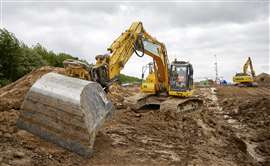How construction machine control technology can help reduce carbon emissions
14 August 2023
Machine control is important proof of progress as construction’s carbon footprint comes under the spotlight, says Topcon’s Luc Le Maire
 Image supplied
Image supplied
A much larger portion of the European construction industry will have to take a long look at its environmental impact as groundbreaking sustainability reporting legislation comes into force in early 2024.
As the ink dries on a new report, The Future of Machine Control from Topcon Positioning Solutions, senior vice president & general manager for the company’s business unit EMEA, Luc Le Maire, explains how machine control technology can help reduce emissions and signal a commitment to sustainable future operations.
Le Maire says, “The Corporate Sustainability Reporting Directive (CSRD) represents a serious shift in the regulatory landscape for construction companies in the EU, one that will a establish sustainability reporting practice that mirrors that of financial reporting.
“It’s safe to say that all large construction businesses will be affected, as well as a significant number of SMEs. Crucially, this reporting isn’t just about the numbers; disclosures will have to include aspects of business strategy and governance that impact environmental impact.
“Long story short, it’s time for the industry to show that it’s acting to bring emissions down.”
Having surveyed 1,000 managers and above across the European construction industry, Topcon’s new research report, The Future of Machine Control, sheds light on an industry optimistic about its ability to decarbonise.
More than two thirds (67%) of respondents agreed that construction would hit net zero by 2050 – but 30% still highlighted hitting sustainability targets as a key challenge on projects. Machine control is a significant step that construction businesses can take now towards greener operations, Le Maire contends.
Doing more with less
According to Le Maire, “Construction companies are under pressure from all sides; soaring material costs, shrinking margins, and steadily rising demand have put the emphasis on efficiency in a difficult market.
“This focus is as much a question of sustainability as it is profitability, as clients are equally concerned with wasted emissions as they are wasted budget.
“This is where machine control can be a game-changer – the improvements in demand from clients mirror those most selected as the main benefits of machine control in our research, with accuracy and improving efficiencies both chosen by a quarter of respondents.
“Combine that with the fact that machine control emerged as the joint most selected factor for meeting future sustainability goals, and the consensus is clear – a more efficient and accurate industry is a more sustainable one.
“A lot needs to change before construction hits net zero, but machine control can be a crucial catalyst for construction companies looking to reach higher levels of accuracy and efficiency, deliver lower carbon footprints for clients, and submit healthier sustainability reports when the new CSRD comes into effect.”
Digging into the detail
One of the major challenges that many businesses will face when the time comes around to submit emissions reports is quantifying their impact.
 Luc Le Maire
Luc Le Maire
Le Maire says, “On large-scale projects with lots of machine movements, assessing the environmental impact is a big undertaking. As construction technology develops, so does the data we’re able to collect about the work we’re doing.
“This leads to smarter, more accurate projects, but collecting and marshalling that data is no small undertaking for construction managers. In fact, more than a quarter of respondents (28%) in our research told us that managing complex project data was a key challenge they faced, demonstrating that this is by no means a minor inconvenience.
“The prospect of submitting sustainability reports in the same level of detail as financial reports will only compound this challenge.
Machine control and digital workflow systems collect data automatically and display it with an intuitive interface. This includes machine movements, fuel usage, and resource expenditure, all of which are crucial to determining a project’s carbon footprint.
These figures can then be easily exported into sustainability reports that can be shared with key stakeholders, clients, or the relevant authorities.
Le Maire says that, alongside reporting on the current situation, machine control can be crucial to driving positive change. Insights extracted from sustainability data can be taken into the cab to guide operators on how to work more sustainably.
This can all be done remotely, without the need for carbon-intensive trips to site for decision makers.
Just the beginning
Reporting legislation is just one part of the EU’s drive to net zero in the built environment and beyond. “You can’t manage what you can’t measure,” says Le Maire, adding “The CSRD will undoubtedly be followed by regulations that mandate construction businesses to reduce rather than just report their carbon footprints, and embracing technology such as machine control can be a powerful statement of that intention for companies that aren’t in a position to completely restructure their operations.
“Building a fluency with the sort of sustainability data that the CSRD requires will also serve businesses well in a future in which the relationship between construction and data will only become closer.”
For the next generation of industry leaders, this will be a significant issue – the proportion of respondents to the Topcon survey who highlighted managing complex project data as a key challenge in our research rises to almost half (46%) among those aged 25–34.
“Equipping them with the tools they need to do this effectively and consistently will be crucial,” says Le Maire.
He adds that machine control can also be the key to a future of collaborative success, saying, “Modern construction projects involve collaboration between multiple stakeholders and have an impact on all of their carbon footprints.”
The new legislation reflects this, with companies having to consider their impact on the wider business ecosystem.
According to Le Maire, “The accurate, intuitive and shareable sustainability reports that we can create with automation and digital workflow technology will smooth the road significantly as we strive together towards a net zero industry.
“Our research found an industry optimistic about a sustainable future for construction, and successful implementation of the CSRD is a crucial step to achieving it.
“It will be a challenge, but machine control can be a significant helping hand for construction businesses already navigating a difficult market. This is a change we can make now and an opportunity that we can’t afford to miss.”
To view The Future of Machine Control report, visit: https://www.topconpositioning.com/future-machine-control-2023-report
STAY CONNECTED




Receive the information you need when you need it through our world-leading magazines, newsletters and daily briefings.
POWER SOURCING GUIDE
The trusted reference and buyer’s guide for 83 years
The original “desktop search engine,” guiding nearly 10,000 users in more than 90 countries it is the primary reference for specifications and details on all the components that go into engine systems.
Visit Now
CONNECT WITH THE TEAM










